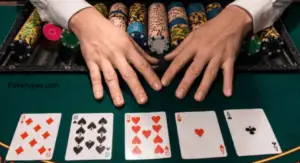The art of playing Texas Hold’em and the art of winning it are totally different. If you are new to Texas Hold’em, you cannot expect to learn and immediately beat professional players or even players at the median level.
This is similar to reading a manual on how to drive a car and then immediately beginning to drive one.
It is obvious you are going to crash. To drive a car safely, you need an experienced driver to provide strategies and provide guidance on how to apply these strategies, tips, and tricks.
Similar to this, you need to be aware of the Texas Hold’em strategies in order to polish your skills and win at Texas Hold’em.
Renowned poker pros, such as Phil Ivey and Daniel Negreanu, have long emphasized the importance of developing a comprehensive understanding of Texas Hold’em strategy.
Ivey, often regarded as one of the greatest players of all time, has stressed that “the key to winning at poker is not just about the cards you are dealt, but how you play them.”
Negreanu, a six-time World Series of Poker (WSOP) bracelet winner, echoes this sentiment, advising players to “focus on making the right decisions, not just getting lucky.
Therefore, if you practice these strategies for a while you will be able to easily dominate other poker players.
We have created a list of strategies that are equally important for beginners and professionals to become successful pro poker players.
No experience is needed, just practice and master our strategies. Once this has been accomplished, you will be able to play at any poker table around the globe.
9 Key Texas Hold’em Strategies and Tips from Pros to Become a Pro
1. Beat the Microstakes First

The first step to higher stakes is mastering micro stakes. While it may be tempting to jump right into higher buy-ins, it is essential to establish a solid foundation at the lowest levels. You must crawl before you can walk.
Players should learn the fundamentals and build a bankroll at micro stakes before moving up.
When you practice micro limits, you can sharpen your skills, experiment with strategies, and gain confidence without risking a lot of money.
Even though micro-stakes games are frequently dismissed as “easy money,” they present players with unique challenges that help shape well-rounded individuals.
At the micro level, the ability to identify tricky spots read opponents’ tendencies, and exploit them translates directly to higher stakes.
The poker coach Jonathan Little says in his book “Mastering Small Stakes No-Limit Hold’em” that “competent players who generally play higher stakes will beat micro stakes games, but not how much they ought to.
Why? Because they don’t understand how to adjust correctly.” Thus, to achieve long-term success in Texas Hold’em you must master the fundamentals of microstakes.
2. Enter the Pot with a Preflop Raise

When you raise the preflop, you get several major advantages over limping in. When you raise your hand pre-flop, you gain more control over the hand’s progression.
In the first place, raising enables you to build a larger pot with your strong hands.
Raise preflop when you have a premium hand, such as pocket aces or kings, in order to entice your opponents to see the flop and compete for a larger pot. This increases your potential winnings if you hit your hand.
In contrast, limping into a hand when the odds are good gives your opponents a greater chance of calling and seeing the flop, possibly reducing your hand’s value.
Additionally, raising the preflop helps you fold out weaker hands that would otherwise call and see the flop.
This narrows the field and improves your chances of winning the hand, especially when you have the best starting cards.
Pre-flop raises give you fold equity, which is really important. Finally, taking the initiative preflop gives you the opportunity to dictate the action and place your opponents on the defensive.
In this way, you are able to control the flow of the hand and make more profitable decisions on subsequent streets.
Doyle Brunson, in his book Super System, says, “The most important thing in poker is position. If you have the initiative, you can control the action.”
3. Make Liberal Use of the 3-Bet

3-betting is an essential tactic in poker that helps build the pot and extract value from opponents.
This strategy involves re-raising an opponent’s initial bet and is typically employed with strong hands to increase the pot size and make opponents fold weaker hands.
It is particularly effective against weaker players who might not fold to a single raise but will often fold to a 3-bet.
Premium hands such as pocket aces, kings, and queens are ideal for 3-betting due to their high probability of winning.
By 3-betting with these hands, players can build the pot and maximize their potential winnings.
Furthermore, 3-betting can isolate weak players who may struggle to make decisions when faced with a re-raise, often leading to larger pots.
Adjusting the 3-betting strategy based on opponents’ tendencies is crucial. For example, against players who fold frequently to 3-bets, incorporating more bluffs can be effective.
Conversely, against players who rarely fold, focusing on value hands is more profitable.
4. Understand the Value of Pocket Pairs

A successful poker strategy is based on mastering pocket pairs or starting hands, which are straightforward but require strategic finesse.
Premium pairs or premium starting hands like Aces, Kings, Queens, and Jacks should be played aggressively with raises and re-raises pre-flop to build the pot and protect your hand.
Medium pairs such as 5s, 6s, 7s, and 8s are excellent for set-mining, where the goal is to hit a set on the flop and potentially win a large pot; therefore, calling in early positions and raising in late positions can be advantageous.
Small pairs, including 2s, 3s, and 4s, are trickier due to their limited post-flop strength and should be folded in early positions and called in late positions only if the set is a viable goal.
Expert players like Bart Hanson emphasize the need to adjust play based on the situation, advising caution with small pairs in early positions against skilled players.
5. Bet for Value on the River

In poker, value betting on the river is key to winning chips from opponents with worse hands. The river is the most important street to play, as it offers the last opportunity to bet and maximize the pot.
A successful value bet involves identifying hands that will pay off against an opponent’s range, which may vary significantly based on the opponent’s style of play.
For instance, loose-passive players are more likely to call with worse hands, making them ideal targets for value bets.
Players should also consider the opponent’s tendencies and the board texture to determine the best bet size. A common mistake is underbetting the river, which can result in missed opportunities.
A good value bet requires a balance between betting too much and too little, since overbetting can cause unnecessary losses and underbetting can lead to losses.
In her book Think in Bets, Annie Duke emphasizes making informed decisions based on uncertainty, ensuring objectivity and accuracy.
6. Fold When You’re Unsure

Poker is a game that demands discipline, and knowing when to fold weak hands is one of the most critical skills to master.
As top poker professionals like Daniel Negreanu have emphasized, “Folding is the most important skill in poker.” If you’re unsure about the strength of your hand, it’s probably better to fold.
Chasing draws, such as trying for a straight or flush when the odds are against you, is a common mistake among newer players.
Experienced players understand the importance of folding these hands unless the pot odds clearly justify a call.
Similarly, playing weak starting hands like 7-2 offsuit or J-8 suited in the hopes of hitting a lucky flop can lead to long-term losses.
It is essential to have the discipline to fold these hands pre-flop, even if the action suggests others may also be playing weak hands.
If you avoid these high-risk, low-reward plays, you will preserve your stack and be able to wait for more advantageous opportunities.
7. Understand Your Opponents

The key to success in any competitive field is to understand the tactics of your opponents. If you closely observe how they play, you will be able to predict their moves and adjust your strategies accordingly, giving you a strategic advantage.
Top professionals highlight the importance of this skill, as it allows for informed decision-making and tactical adaptation based on the specific strengths and weaknesses of your opponents.
Once you identify these patterns, you can modify your strategies to counter their approach.
This might involve playing more defensively or aggressively, concentrating on certain strengths or weaknesses, or even completely changing your game plan.
With such a tailored approach, you can neutralize their advantages and capitalize on their weaknesses, thereby significantly increasing your chances of success.
8. Manage Your Bankroll Wisely

Proper bankroll management is essential for long-term success in gambling. It involves setting appropriate stakes and buy-ins to ensure you do not risk more than you can afford to lose.
Professional players stress the importance of this discipline, as it helps you endure losing streaks and increase your chances of making a profit over time.
Experts generally recommend risking no more than 1-2% of your total bankroll on a single bet or hand. This conservative strategy reduces the impact of short-term losses and protects your overall bankroll.
When it comes to buy-ins, it is advisable to have a bankroll that is 50-100 times the size of your usual bet. This buffer helps you handle fluctuations and avoid going bust from a series of bad luck.
Renowned professional player Phil Ivey once said, “Bankroll management is the most important aspect of gambling. If you can’t manage your bankroll, you can’t play the game.”
9. Avoid Common Beginner Mistakes

As a beginner in poker, it is important to avoid common mistakes that can quickly drain your bankroll. One frequent error is calling too many hands before the flop, hoping to hit a lucky draw.
This often results in playing too many hands out of position, making it difficult to make profitable decisions later in the game.
Another common mistake is bluffing too often or at inappropriate times. Although bluffing is a crucial part of poker, beginners tend to overdo it, which leads to lost chips and frustrated opponents.
When you concentrate on a narrow range of strong hands and apply pressure with well-timed bets and raises, you can maximize your winnings and minimize your losses.
As you gain more experience, you can gradually expand your range of starting hands and incorporate more advanced strategies.
Conclusion
To excel at Texas Hold’em, one must understand hand rankings, develop a solid preflop strategy, and adapt to various situations at the table.
Start by focusing on beating the microstakes, which provide a strong foundation. Always enter the pot with a preflop raise and make good use of the 3-bet to apply pressure on your opponents.
Continuous learning and practice are crucial to staying ahead in the game. As poker legend Phil Hellmuth says, “You can’t win at poker without practice.”
Similarly, Mike Caro, a renowned coach and author, highlights the importance of learning from mistakes and adapting to new situations.
These strategies can help you significantly improve your poker skills if you follow them and commit to continuous practice and learning.
Always remember, Poker is fundamentally a game of skill and strategy. With dedication and perseverance, anyone can enhance their abilities and achieve their goals at the poker table.























































